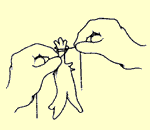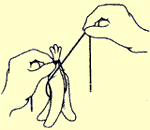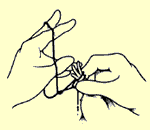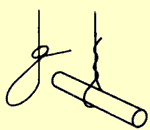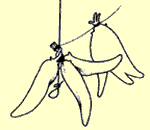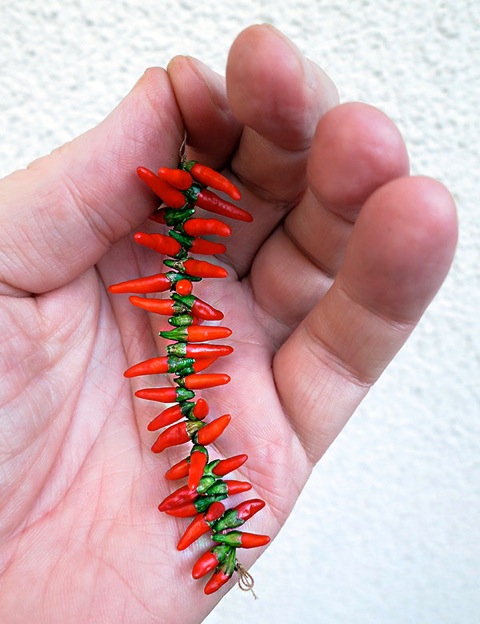The ristra, or chile string, is the oldest and also the most attractive method for drying peppers, and it is still customary in many chile-producing countries. There are several different ways of assembling these strings.
Traditional New Mexican ristras are made by tying New Mexico red chiles together in clusters of three, with cotton string (this works with various other chiles as well).
When all the chiles have been strung by threes, they then get braided onto a length of strong twine or wire. Hanging the twine from an overhead support greatly simplifies this stage of assembly. Braid the chiles from the bottom of the twine as if braiding hair, using the twine as one braid and chiles from each grouping as the other two. Be sure to push each group down tightly against each other to insure an attractive, full-bodied ristra.

These days, some ristra makers have resorted to using rubber bands to “tie” up the groups of three chiles, then slipping each group over a wire to form the ristra. This method is considerably faster than the traditional method; the downside is that the ristras tend to be a bit thin or skinny and last only as long as the rubber bands hold out.
One final method to make a ristra is to use a large needle threaded with string. Push the needle through the bottom of the stem where it widens out, pushing the chiles up tightly against each other. Again this tends to produce thin looking ristras, but this can be overcome by hanging several strings together. It is also a handy way to handle smaller chiles such as cayennes or piquins, which require a lot of time and dexterity to string in the traditional way.
Unless you live in an arid climate, it is important to dry your ristras in a location where the air circulates freely. If hung inside a home in a damp climate, there is a good chance that some of the chiles will rot. Hung from a tree, or in an open porch should give the ristra a good chance to dry properly. If a few of the chiles do start to rot, just pull them off the string; if you’ve got a nice full ristra, you’ll never miss them!
Another good reason to dry your ristra outside is that if any of the chiles start to rot, they may start dripping a liquid that will stain anything it touches. (After all, red chiles are used to produce red coloring that is used in food products.) So you might want to reconsider before hanging your fresh ristra over your 2-inch deep, snow white pile carpet. And one final disturbing note: chiles that turn bad attract fruit flies by the zillions. Obviously, it makes a lot of sense to hang them outside to dry!
Learn more about drying and using your freshly-grown chile peppers in this story.
The following two tabs change content below.


Publisher | Christened the "Pope of Peppers" by The New York Times, Dave DeWitt is a food historian and one of the foremost authorities in the world on chile peppers, spices, and spicy foods.
Latest posts by Dave DeWitt (see all)
- Enchiladas Verdes con Chile Pasado - 02/08/2023
- Smoked Oysters with Ancho Chile Sauce - 01/13/2023
- Machaca Sierra Madre - 01/11/2023








